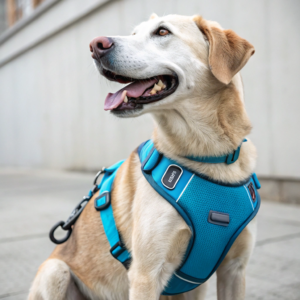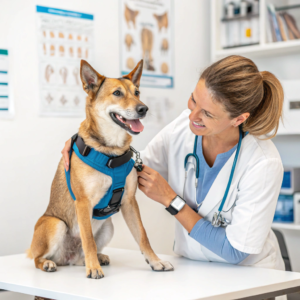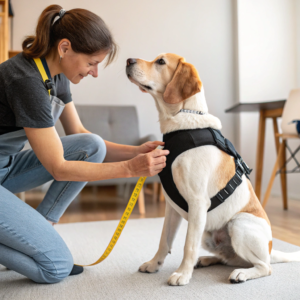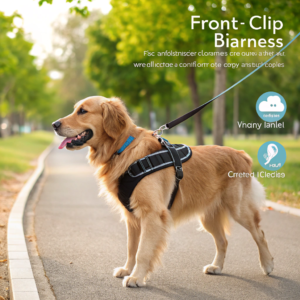What Are the Best Dog Harnesses for Walking?
Every dog owner knows the struggle of a leash-pulling pup. The constant tugging hurts your arm, endangers your dog’s neck, and makes walks stressful instead of enjoyable for both of you.
**The best dog harnesses for walking provide control without causing discomfort. Look for harnesses with adjustable straps, proper fit (allowing two fingers of space between harness and body), and features that match your dog’s behavior, such as Look for harnesses with adjustable straps1, proper fit (allowing two fingers of space between harness and body), and features that match your dog’s behavior, such as front clips for pullers or padded options for sensitive dogs
 !
!
I remember my first walks with Max, my energetic Labrador. Those chaotic walks transformed into pleasant experiences once I found the right harness. Let me help you understand what makes a good harness and how to choose one that works for both you and your furry friend.
What Harness Do Vets Recommend For Dogs?
Many dog owners rely on collars, but veterinarians increasingly caution against them. Collars can damage the trachea and spine when dogs pull, leading to long-term health issues that could be easily avoided.
**Veterinarians typically recommend Veterinarians typically recommend back-clip or Y-shaped harnesses for dogs with respiratory issues or neck injuries, and front-clip or dual-clip harnesses1 for pullers

When I discussed harness options with my vet after Max developed slight tracheal irritation, she emphasized the importance of choosing the right style based on both health and behavior factors. Vets typically base their recommendations on several key factors that prioritize your dog’s safety and comfort.
Most veterinarians prefer harnesses with specific features that protect dogs’ physical wellbeing. They look for designs that distribute pressure evenly across the chest rather than concentrating it on vulnerable neck areas. For brachycephalic breeds (like Bulldogs or Pugs), harnesses that reduce pressure on their already compromised breathing systems are crucial.
Here’s a breakdown of vet-recommended harness types for different dog needs:
| Dog Condition/Need | Recommended Harness Type | Key Features |
|---|---|---|
| Respiratory issues | Y-shaped back-clip | Keeps pressure away from throat |
| Neck injuries | Vest-style with back attachment | Distributes weight across torso |
| Excessive pullers | Front-clip or dual-clip | Provides steering control |
| Anxious dogs | Padded, full-coverage designs | Provides security feeling |
| Small/fragile breeds | Lightweight, padded styles | Prevents chafing on delicate skin |
The quality of materials matters significantly too. My vet pointed out that cheap harnesses with rough edges can cause hair loss and skin irritation over time, which is why investing in a well-made harness is worth it for your dog’s comfort.
How Do I Choose the Right Dog Harness?
Standing in the pet store aisle, I felt overwhelmed by the dozens of harness options. Different styles, materials, and features made the decision confusing, and I worried about wasting money on something my dog would hate.
To choose the right dog harness, measure your dog’s chest girth, neck circumference, and weight. Consider your dog’s behavior (puller, sensitive, escape artist) and walking conditions. For pullers, select front-clip harnesses; for sensitive dogs, choose padded options; and for escape artists, look for For pullers, select front-clip harnesses1; for sensitive dogs, choose padded options; and for escape artists, look for secure designs with multiple adjustment points.

Finding the perfect harness for Max took trial and error. After three different purchases, I finally found one that worked for both of us. The right harness should address your specific needs while keeping your dog comfortable and secure during walks.
Selecting an appropriate harness requires consideration of several factors beyond just getting the size right. A proper harness should take into account your dog’s physical build, behavior patterns, and the specific activities you’ll be doing together. This careful selection process helps prevent discomfort, escape risks, and training setbacks.
Start by understanding the different harness styles available:
| Harness Type | Best For | Potential Drawbacks |
|---|---|---|
| Standard back-clip | Calm, trained dogs | Limited control with pullers |
| Front-clip | Training, pulling reduction | May tangle with legs if poorly fitted |
| Dual-clip (front & back) | Versatility, transition training | More expensive, bulkier |
| Step-in harness | Easy on/off, good for sensitive dogs | Sometimes less secure |
| Vest/padded harness | Comfort, distributing pressure | Can overheat some dogs |
When measuring your dog, I’ve learned that chest girth (measured at the widest part behind the front legs) is the most critical measurement. Always refer to the manufacturer’s specific sizing guide, as they aren’t standardized across brands. Remember that puppies need regular resizing as they grow.
Consider your walking environment too. If you walk in low-light conditions, reflective elements or bright colors enhance visibility. For active dogs who enjoy hiking or swimming, look for durable, quick-drying materials with reinforced attachment points. The right material can make a significant difference in comfort and durability – nylon is lightweight but can chafe, while neoprene offers padding but less breathability.
Do Front Clip Harnesses Stop Pulling?
Before discovering front-clip harnesses, walks with my dog were a constant battle. He pulled so hard I developed shoulder pain, and I worried he would slip his collar and run into traffic during our walks.
**Front-clip harnesses significantly reduce pulling by redirecting a dog’s forward momentum sideways when they pull, making the behavior less rewarding. While they’re not a complete solution on their own, these harnesses provide immediate management of pulling while giving owners the opportunity to train While they’re not a complete solution on their own, these harnesses1 provide immediate management of pulling while giving owners the opportunity to train loose-leash walking skills

The first time I tried a front-clip harness with Max was nothing short of miraculous. Instead of being dragged down the street, I finally had some control. However, I quickly learned that the harness alone wasn’t a complete solution – it was a tool that gave us the opportunity to work on proper walking techniques.
Front-clip harnesses have become increasingly popular for managing dogs that pull, but understanding how they work helps set realistic expectations. These harnesses feature a leash attachment point on the dog’s chest rather than on their back. This positioning creates a mechanical advantage that works with canine psychology to discourage pulling behavior.
The science behind front-clip harnesses is straightforward but clever. When a dog pulls forward, the front attachment point causes a slight sideways turning motion rather than allowing the dog to move directly forward. This opposes a dog’s natural pulling instinct by making the pulling behavior less efficient and rewarding. Over time, many dogs learn that pulling no longer achieves their goal of moving forward quickly.
However, effectiveness varies based on several factors:
| Factor | Impact on Effectiveness |
|---|---|
| Dog size and strength | More powerful dogs may still pull despite the mechanism |
| Proper fit | Too loose and the harness loses effectiveness |
| Combined with training | Much more effective when paired with consistent training |
| Dog’s sensitivity | Some dogs are more responsive to the redirect than others |
| Walking pace | More effective when maintaining a brisk, engaging pace |
I’ve found that front-clip harnesses work best as part of a comprehensive approach to leash manners. Using the harness consistently while implementing positive reinforcement for loose-leash walking creates lasting results. Many trainers recommend marking and rewarding moments when your dog chooses to walk without tension on the leash.
For dogs with extreme pulling issues, dual-clip harnesses offer an excellent transition tool. These feature both front and back attachment points, allowing you to use a double-ended leash or gradually transition from front to back attachment as your dog’s leash skills improve.
Conclusion
Finding the right harness requires understanding your dog’s needs, proper measurement, and matching features to your walking goals. Whether vet-recommended for health or front-clip for training, the perfect harness makes walks enjoyable for both you and your furry friend.

